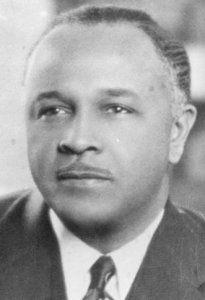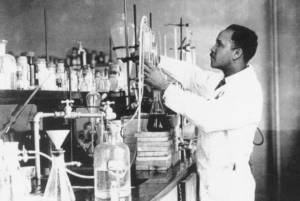By Jenna Beam
When I started researching Percy Julian for this article, I was amazed by all the information I found. Dr. Julian was a member of the National Academy of Science, has been listed on “Inventors Who Changed the World” by DePauw University, and was inducted into the National Inventors Hall of Fame. He developed affordable, large-scale manufacturing of synthetic human hormones, ultimately giving us things like birth control and cortisone for the treatment of rheumatoid arthritis and other inflammatory diseases. He was the first person to successfully synthesize the chemical physostigmine, which is used for the treatment of glaucoma. His advancements made treatments for a wide variety of diseases affordable and accessible. Yet – I’ve never even heard his name, let alone learned about what he did for the medical field. So come with me, while we learn together, about how this man helped shape modern medicine.
Percy Julian was born the grandson of slaves in 1899 in Montgomery, Alabama. Dr. Julian attended school until the 8th grade, but because of Jim Crow Laws (read about them here and here), Black students were prohibited from attending high schools for white students and there were no high schools for Black students in Montgomery. Instead Dr. Julian attended an all-Black normal school, where students are trained to become teachers. Upon graduating in 1916, Dr. Julian applied to DePauw University in Indiana. However, he was deemed to have received inadequate education and was admitted as a “sub-freshman.” This meant that he had to take high school courses at night, in addition to his college courses during the day. Dr. Julian ultimately ended up graduating from DePauw as Valedictorian in 1920, after which worked as an instructor at Fisk University before earning a fellowship in chemistry to complete a Masters degree at Harvard University. It is reported that Harvard did not allow Dr. Julian to pursue his PhD at Harvard, resulting in Dr. Julian completing his PhD at the University of Vienna, Austria in 1931.
I want to pause here. I, by no means, intend to distract or diminish Dr. Julian’s ambition, perseverance, or success. I do, however, want whomever is reading this to take a moment and reflect on the story I just told you. This man, who reshaped the medical field, was prohibited from obtaining a high school education. Beyond that, he had to work harder and longer than his white counterparts to graduate college. Beyond that, despite being more than qualified, racial discrimination and prejudice led to Dr. Julian being rejected from multiple job opportunities. While this all may seem like a thing of the past, I invite you to read this article by Dr. Akiko Iwasaki and this article from NOVA and think about how race affects one’s ability to advance, not only in science, but in other careers as well.
After earning his PhD, Dr. Julian and his colleague, Dr. Pikl from the University of Vienna, moved back to the United States where they worked at Howard University before returning to DePauw University. At DePauw, in collaboration with students, Drs. Julian and Pikl successfully synthesized physostigmine from Calabar beans for the treatment of glaucoma. Despite this momentous achievement, the Board of Trustees at DePauw did not allow Dr. Julian’s promotion to professor and Dr. Julian left the university.
Dr. Julian ultimately took a job with the Glidden Company in Chicago as the head of the Soya Division where he worked to synthesize steroids and hormones, as well as Aero-Foam, a soya protein-based fire extinguisher used by the US Navy during World War II.
Dr. Julian later left the Glidden Company and started Julian Laboratories, with campuses in both Chicago and Mexico City. He became the largest employer of Black chemists in the United States, and one of the first Black millionaires when he sold Julian Laboratories in 1961. Dr. Julian was elected to the DePauw University Board of Trustees in 1967. In 1973, Dr. Julian was the second Black scientist, and the first Black chemist, inducted into the National Academy of Science. Dr. Julian died of liver cancer in 1975.
To read more about Dr. Julian, check out the sources below! Bonus: you can check out this article for more Black scientists that we should all know about.
Sources (many are hyperlinked in the article text):
http://www.nasonline.org/member-directory/deceased-members/20001466.html
https://www.pbs.org/wgbh/nova/julian/lrk-whowasjulian-exp.html
https://www.depauw.edu/news-media/latest-news/details/34537/
https://www.biography.com/scientist/percy-julian
https://www.acs.org/content/acs/en/education/whatischemistry/landmarks/julian.html
https://www.sciencehistory.org/historical-profile/percy-lavon-julian
https://www.invent.org/inductees/percy-lavon-julian
https://www.pbs.org/wgbh/nova/julian/time-nf.html
Edited by Candice Crilly and Elise Hickman


